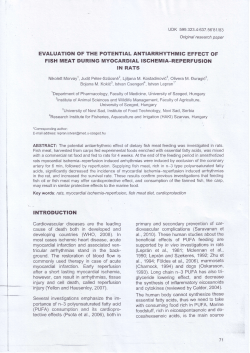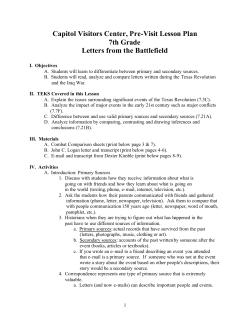
Red TAKING CARE OF THE CATCH
TAKING CARE OF THE CATCH Red snapper are excellent table fare, bringing top dollar at your local seafood market. Taking good care of the catch prior to cooking is important. The delicate nature of the flesh makes it particularly susceptible to spoilage. Clean and place your fish on ice as soon as possible. Red snapper can be easily filleted for frying or grilling, or simply scaled and gutted for baking. Recipes for preparation of red snapper and other Texas seafoods are available by writing: Texas Sea Grant College Program 2700 Earl Rudder Freeway S., Suite 1800 College Station, Texas 77845 For more information about red snapper, the Artificial Reef Program or other coastal issues, contact your nearest TPWD Coastal Fisheries Division office. 4200 Smith School Road, Austin, Texas 78744 www.tpwd.state.tx.us © TPWD 2010 PWD BR V3400-608 (8/10) Printed on recycled paper. In accordance with Texas State Depository Law, this publication is available at the Texas State Publications Clearinghouse and/or Texas Depository Libraries. TPWD receives federal assistance from the U.S. Fish and Wildlife Service and other federal agencies and is subject to Title VI of the Civil Rights Act of 1964, Section 504 of the Rehabilitation Act of 1973, Title II of the Americans with Disabilities Act of 1990, the Age Discrimination Act of 1975, Title IX of the Education Amendments of 1972, and state anti-discrimination laws which prohibit discrimination the basis of race, color, national origin, age, sex or disability. If you believe that you have been discriminated against in any TPWD program, activity or facility, or need more information, please contact Civil Rights Coordinator for Public Access, U.S. Fish and Wildlife Service, 4401 N. Fairfax Drive, Mail Stop: MBSP4020, Arlington, VA 22203. COASTAL FISHERIES Red Snapper IN TEXAS The red snapper (Lutjanus campechanus) is one of the most popular food and sport fish caught in Texas. Many restaurants proudly include red snapper on their seafood menus. Red snapper range from Massachusetts to the Yucatan Peninsula in Mexico and are highly sought after by both recreational and commercial anglers. In Texas, red snapper can be found in offshore waters on or near the bottom at natural reefs, artificial reefs, drilling platforms and ridges or humps. IDENTIFICATION Red snapper are usually a deep rosy red color with a dark fringe around the dorsal and tail fins. Young fish have a black spot located just below the soft dorsal fin. This spot usually disappears with size and age. They are relatively deep-bodied with a sloping head and large mouth, which contains sharp teeth that can easily cut a finger. Their gill plates are also sharp, and care should be taken when handling them. Other red-bodied snappers can be confused with the red snapper. For example, the lane snapper (Lutjanus synagris) has a similar body shape and color, but it also has eight narrow yellow lines that run the length of the fish. It also has a black spot on each side; but unlike the red snapper, the spot stays with the lane snapper its entire life. Also, red snapper have an angular anal fin and 14 soft dorsal rays, while lane snapper have a rounded anal fin and 12 – 13 soft dorsal rays. Fig. 1 RED SNAPPER Angular anal fin 14 dorsal rays LANE SNAPPER Rounded anal fin 12-13 dorsal rays Due to differences in bag and size limits among snappers, learning how to distinguish between species is very important to anglers. AGE AND GROWTH Red snapper grow quickly during their first few years of life but more slowly after 5 years of age. Average lengths at age for red snapper in the Gulf of Mexico are shown in the table below. AGE LENGTH 9 inches 13 inches 15 inches 18 inches 21 inches 31 inches 1 2 3 4 5 10 The state record, caught in 1998, was 38 inches long, weighed 37.5 pounds and must have been a very old fish. Researchers have aged red snapper from the northeastern Gulf of Mexico at over 50 years old. FOOD HABITS MANAGEMENT FISHING METHODS As with most fish, red snapper aren’t picky eaters. In fact, the name “snapper” comes from the fish’s propensity to rise to the surface and “snap” at anything in the water, including bare hooks. Most of the red snapper’s opportunistic diet consists of a wide variety of fish, mollusks and crustaceans, with adults eating mostly fish. Amazingly, most of the red snapper’s prey items are found not over reefs but over sand, shell or mud bottoms adjacent to reefs. The U.S. government, through the National Marine Fisheries Service (NMFS), manages recreational and commercial red snapper fishing in the federal waters of Gulf of Mexico from 9 – 200 nautical miles offshore. The State of Texas manages red snapper in state waters out to 9 nautical miles. Red snapper recreational fishing in federal waters is managed using a quota system. Under guidelines established by the Magnuson-Stevens Fishery Management and Conservation Act, NMFS is mandated by law to close the recreational fishery for the remainder of the year when the quota is reached. The typical fishing rig is a heavy action rod with a reel with a carrying capacity of several hundred yards of 50-pound test line. The terminal tackle is usually a double circle hook set up with a heavy lead weight. It is not uncommon to fish with almost a pound of weight to get your bait to the bottom and keep it in place when fishing in deep water with strong currents. Sometimes, when fishing in water deeper than 150 feet, electric reels are used to help alleviate the strain of reeling in such heavy weights over and over again. SPAWNING Spawning takes place during the day and peaks in late afternoon in offshore waters approximately 180 – 300 feet deep over firm, sandy bottoms near reefs. Red snapper have a protracted spawning season. That is, they may spawn several times during the spawning season, from April-May through September-October. Spawning frequency and egg production increases with age. An 11-yearold fish can produce over 3 million eggs. Most red snapper reach full sexual maturity by the end of their fourth year. MOVEMENT The commercial fishery is managed under a limitedaccess privilege program with individual fishing quotas assigned to eligible reef fish permit holders. Because each permit holder is assigned a defined proportion of the commercial allowable catch, the commercial fishery can remain open year-round. Over 95 percent of the red snapper landed in Texas come from federal waters. Thus, when NMFS decides to change management practices in federal waters, it affects Texas anglers. For current bag and size restrictions, check with the nearest TPWD Coastal Fisheries or Law Enforcement office. Tagging studies have shown that once red snapper become attracted to a reef or structure, they move very little. They travel only to nearby reefs or other structures unless a nearby hurricane causes them to move further away. This site fidelity is what makes red snapper particularly susceptible to over-fishing. Recreational and commercial anglers can target a particular reef and literally catch all the red snapper from that reef. Anglers can help fishery managers protect reef communities by not over-fishing a particular reef and by changing locations from trip to trip, to allow replacement of those fish already harvested. In Texas, another management tool for red snapper and other Gulf species is the Texas Artificial Reef Program (reef program). These artificial reefs provide excellent locations for invertebrates such as sponges and corals to grow, forming the basis of the reef community. Red snapper and other species use these reefs to find both food and cover. One segment of this program recycles donated petroleum platforms into permanent artificial reefs rather than the petroleum companies taking them ashore and being sold as scrap. In another segment, the reef program deploys a variety of other safe and durable materials to create and enhance artificial reefs. Fig. 2 Distended air bladder and gut lining POINT OF PENETRATION Below fourth or fifth dorsal fin spine Reproduced from Queensland FMA, Australia, 1989 When fish are brought up from deep water, their air bladders may be distended due to the rapid change in pressure. This can cause significant internal organ damage and make it difficult for the fish to return to the bottom if released. Fish that suffer from this condition may be “vented” by gently inserting a sharp pointed object such as a large diameter needle or an ice pick through the side of the fish just behind the upper part of the base of the pectoral fin. You should be able to hear the gases escaping. Once vented, the fish may be released. Often the stomach of a fish with a distended air bladder will protrude through its mouth. Anglers sometimes mistake the stomach for the air bladder. Never attempt to poke a hole in the stomach of the fish. Typically squid are used as bait, but cut fish chunks are also used. Artificial baits, such as heavy spoons, are used in shallower waters and are simply jigged up and lowered down near the bottom. Nevertheless, most red snapper are caught on bait. Head boats capable of carrying numerous anglers and traveling several miles offshore in search of productive snapper reefs land about 80 percent of red snapper. Charter boats or private boats land the remainder. Those head boats operating in Texas account for 200,000 angler fishing trips each year. The typical head boat trip can last five, eight or 12 hours, depending on the destination. Bait and tackle are usually furnished, so all you have to do is show up at the dock and go fishing. Some headboats allow you to bring a cooler for food and drinks aboard, while others sell food and drinks onboard. Headboat operators can be found in almost every port along the Texas coast. Check with the local chamber of commerce for names and phone numbers for headboat operators in the area that you plan to visit.
© Copyright 2025















